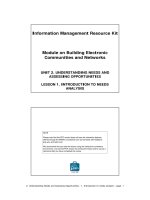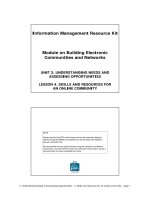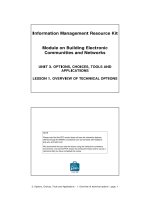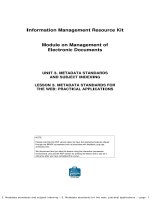UNIT 2. UNDERSTANDING NEEDS AND ASSESSING OPPORTUNITIES LESSON 1. INTRODUCTION TO NEEDS ANALYSIS doc
Bạn đang xem bản rút gọn của tài liệu. Xem và tải ngay bản đầy đủ của tài liệu tại đây (386.2 KB, 9 trang )
2. Understanding Needs and Assessing Opportunities - 1. Introduction to needs analysis – page 1
Information Management Resource Kit
Module on Building Electronic
Communities and Networks
UNIT 2. UNDERSTANDING NEEDS AND
ASSESSING OPPORTUNITIES
LESSON 1. INTRODUCTION TO NEEDS
ANALYSIS
© FAO, 2006
NOTE
Please note that this PDF version does not have the interactive features
offered through the IMARK courseware such as exercises with feedback,
pop-ups, animations etc.
We recommend that you take the lesson using the interactive courseware
environment, and use the PDF version for printing the lesson and to use as a
reference after you have completed the course.
2. Understanding Needs and Assessing Opportunities - 1. Introduction to needs analysis – page 2
At the end of this lesson, you will be
able to:
• understand the role of needs
analysis in building an online
community.
Objectives
A scenario
Keper is an international non-profit organization aiming to support and
serve community radio broadcasters in Africa.
The Keper
office in
Kampala
Some of the organizational goals are to support radio broadcasting
through local action, and offer various services to its members.
2. Understanding Needs and Assessing Opportunities - 1. Introduction to needs analysis – page 3
Keper helps local radios with managing, financing, training and technical
problems, by building and coordinating a regional network of radio
broadcasters.
Radio station
Radio station
Radio stationRadio station
Radio station
Keper
The network is conceived as a
means of distributing information
,
bringing together various
experiences and transferring skills
within the network.
A scenario
INFORMATION PROVIDED BY KEPER
Keper provides affiliates with information on:
• Lobbying for favorable legislative environments through consultative
workshops with stakeholders and awareness building seminars.
• Training and capacity building programmes, research and surveys to
establish training support needs, dissemination of existing training modules
and information for support and capacity building.
• Activities that will enhance sustainability of the initiatives.
• New technology and equipment, telephone and Internet connection,
content development, networking and information sharing.
A scenario
2. Understanding Needs and Assessing Opportunities - 1. Introduction to needs analysis – page 4
Amina works at Keper as a communication specialist. She is in charge of
promoting the communication strategy with members to allow
information exchange and knowledge sharing within the network.
Amina, communication
specialist at Keper
The Keper team mainly use telephone and fax to provide information and
answer members’ requests.
Amina notices that many of the incoming requests are very similar. This
results in repetitions and, considering the high costs of telephone
communications, in poor use of time and money.
A different approach and a multidirectional communication channel is
needed to improve the communication among radio broadcasters.
A scenario
Amina has participated in an interesting workshop about Internet
communication tools.
She has been very impressed by this experience, and she is thinking about
the possibility of using the Internet to improve the communication
strategy in the community.
Using Internet-based tools it is
possible to share information
faster, with lower costs and a
higher level of sharing among
members than with telephone or
fax.
It allows the sharing of solutions
to many members’ common
problems.
A scenario
2. Understanding Needs and Assessing Opportunities - 1. Introduction to needs analysis – page 5
Amina writes down all the benefits that the Internet could offer to the radio
broadcasters, by:
• reducing the isolation of radio broadcasters;
• facilitating dialogue and encouraging participation in
decision making;
• providing information, knowledge and skills training in a
flexible manner;
• helping overcome the barriers that prevent information
sharing.
A scenario
I have plenty of
ideas, but… how to
start?
After the initial enthusiasm, a series of
doubts come to her mind…
Who could support me
during the project?
And, finally, the most
substantial question arises…
Is this really the best
answer to meet the
needs of the radio
broadcasters?
How do I get our staff
to support the
concept?
A scenario
2. Understanding Needs and Assessing Opportunities - 1. Introduction to needs analysis – page 6
An innovative idea is often the
starting point for a new project.
Then, you will go through the
different stages of the process, such
as developing a plan, starting the
online community activities and
evaluating the results.
Before all this, you need to
understand the users’ needs, in
order to closely connect them with
the ultimate plan you will develop.
The role of the needs analysis
You may find it useful to use a logical model to organize the
different stages of the process.
See Annex 2.1.1 for a mini-lesson on using a logical model.
Planning,
implementation,
evaluation
Needs Analysis
Idea
Understanding user’s needs is crucial in defining what you are trying to
achieve and what will happen as a result of the project.
Consider for example the following problems: What has been forgotten in
the needs analysis?
Most members don’t access the
online community, as they have
problems with Internet
connectivity…
The plan is ready but we can’t find
enough money to implement it!
Everything is implemented but
nobody participates… It seems that
community members don’t
understand the web interface…
Communication context analysis.
Analysis of the financial barriers
to electronic networking.
Analysis of the technical
barriers to electronic
networking.
Click on each option and drag it in the corresponding box.
When you have finished, click on the Confirm button.
a
1
The role of the needs analysis
2. Understanding Needs and Assessing Opportunities - 1. Introduction to needs analysis – page 7
Needs assessment: assessing the needs of the potential
online community members
Defining your idea: building up your team and identifying
goals
Capacity building assessment
Analysing technical, financial, institutional and
social barriers
Needs analysis can be organized around the following activities:
We will discuss each of these activities in the following lessons.
The role of the needs analysis
Summary
The needs analysis stage is carried out to ensure that you are
planning an online community project that:
• is consistent with the interests and needs of the potential online
community members; and
•has all the requirements to be successfully implemented.
2. Understanding Needs and Assessing Opportunities - 1. Introduction to needs analysis – page 8
The process
NEEDS ANALYSIS
PLANNING
IMPLEMENTATION
EVALUATION
When you start the online community building process, you may refer to
a step by step needs analysis, planning, implementation and evaluation
effort that results in a clear path to follow as you move forward.
NEEDS
ANALYSIS
EVALUATION
IMPLEMENTATION
PLANNING
Over time, as you further refine your
assumptions and expectations, you will shift
from a step-by-step process to an ongoing
process that resembles a cycle of learning
and action.
Annex 2.1.1
Mini-lesson: Using a Logical Model
The logical model
The tasks that
have to be
completed to
produce the
results.
GOALS
OBJECTIVES
RESULTS ACTIVITIES
The longer-
term benefits
to final
beneficiaries
and the wider
benefits to
other groups.
The tangible
consequences of
implementing a set of
Activities.
The accomplishment
to be achieved by
implementing the
project and which is
likely to outlive the
project.
A single tool that can help you organize your thinking over time is to use a
logic model to organize your thoughts and what you learn during the
process.
The logic model helps you keep track of the following information:
2. Understanding Needs and Assessing Opportunities - 1. Introduction to needs analysis – page 9
The logical model
Think of the logical model as a living and
ever changing summary document that
sits above more specific documents like:
• timelines,
• technical specifications,
• evaluation tools and
• many other planning and implementation
documents.
At the initial stage, the logical model will start out with more broadly
framed statements, and later will become more defined.
See the Keper’s logical model
Download the logical model form









